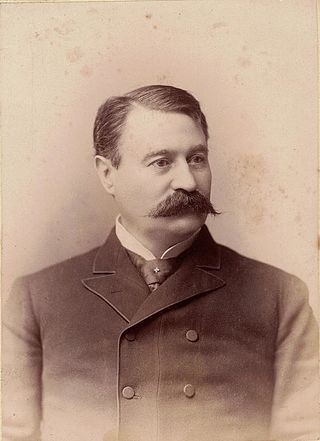
George Louis Palmella Busson du Maurier was a Franco-British cartoonist and writer known for work in Punch and a Gothic novel Trilby, featuring the character Svengali. His son was the actor Sir Gerald du Maurier. The writers Angela du Maurier and Dame Daphne du Maurier and the artist Jeanne du Maurier were all granddaughters of George. He was also father of Sylvia Llewelyn Davies and grandfather of the five boys who inspired J. M. Barrie's Peter Pan.
Wellington Bartley Willoughby, was a Canadian politician and lawyer.

Nicholas Marcellus Hentz was a French American educator and arachnologist.
William Carlton Lanyon Dawe, generally known as Carlton Dawe, was a prolific Australian author of over 70 books including romance, mystery and crime.

Frances Amy Lillian Sherwin, the 'Tasmanian Nightingale', was an Australian soprano singer.
"Don't Fence Me In" is a popular American song written in 1934, with music by Cole Porter and lyrics by Robert Fletcher and Cole Porter. Members of the Western Writers of America chose it as one of the Top 100 Western songs of all time.

Case Broderick was an American politician and jurist who served as Associate Justice of the Idaho Territorial Supreme Court from 1884 to 1888 and as U.S. Representative from Kansas from 1891 to 1899.

Francis Julius LeMoyne was a 19th-century American medical doctor and philanthropist from Washington, Pennsylvania. Responsible for creating the first crematory in the United States, he was also an abolitionist, founder of Washington's first public library, co-founder of the Washington Female Seminary, and an instrumental benefactor to the LeMoyne Normal and Commercial School, to which he made a $20,000 donation in 1870.
Sir Bysshe Shelley, 1st Baronet was the grandfather of English Romantic poet Percy Bysshe Shelley.
Harriet Anne Scott, Lady Scott (1816–1894), was a British novelist, born in India, and of Scottish descent.

Sol Polito, A.S.C. was a Sicilian-American cinematographer. He is best known for his work with directors Michael Curtiz and Mervyn LeRoy at Warner Bros. studios in the 1930s and 1940s.
Claude Martin Blagden was an eminent Anglican bishop in the first half of the 20th century.

Beverly Francis Carradine was an American Methodist minister and a leading evangelist for the holiness movement. He was a productive author, writing primarily on the subject of sanctification. The patriarch of the Carradine family, he was the grandfather of actor John Carradine and great-grandfather of actors David, Keith, and Robert Carradine.
Townsend Nathan North was one of the original pioneers of Tuscola County, Michigan.
R. Edward Earll was an American ichthyologist and museum curator.
Emilia Marryat was an English writer of children's books. The third daughter of the author Captain Frederick Marryat and his wife, Catherine, she followed her father's example by infusing her adventure novels with moral lessons. Occasionally, she published under her married name, Emilia Marryat Norris.

Charles William Turner was a lawyer in Seattle and Montana, and once Adjutant General of Montana. As a youth during the American Civil War, he was a courier for Stonewall Jackson. Subsequently, he was one of the VMI cadets who fought at the Battle of New Market. He later moved to Montana to practice law and engaged in mining pursuits. Turner was shot to death in a Seattle bar by an assassin who was after one of Turner's clients.
John King (1759–1830) was Under Secretary of State at the Home Office from 1791 and was briefly a Member of Parliament for Enniskillen in 1806.

Annie E. Ridley (1839–1923) was a Victorian novelist who wrote books regarding women's education and a science book for children. Not only was Ridley an author, but she was the governor of the Camden School for Girls in London for twenty-four years. She was successful enough to own her own house. Ridley was also involved with the Headmistresses' Association and the Teacher's Guild. Ridley worked with Frances Mary Buss, a pioneer of women's education, and Ridley went on to inspire people like Ellice Hopkins.
William Charles Gotshall was an American civil engineer known for his research on engineering economics in civil engineering published as Notes of electric railway economics and preliminary engineering. He was also responsible for the conversion of the Second Avenue Railroad in New York from horses to conduit electrical power in 1897–1898.








